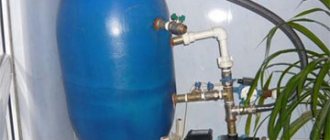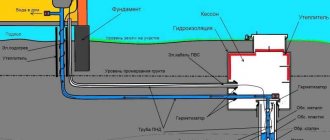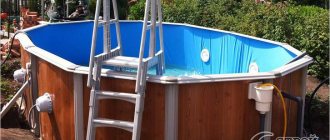Ecology of consumption. Estate: A vacuum cleaner for a swimming pool is an excellent invention for cleaning its surfaces. A DIY pool vacuum cleaner is a simple invention that is even fun to work with.
A pool vacuum cleaner is an excellent invention for cleaning pool surfaces. Regardless of the quality of the installed inlet filter, plaque forms on the walls of the pool and on its bottom. In addition, dirt often gets into the pool in the form of leaves and dust, which, when deposited, creates an unpleasant layer on the surface. Such stains can be removed in many ways, but one of the best is a pool vacuum cleaner. Making it with your own hands is quite simple, and today DachaDecor.ru will help you decide on this task.
Pool cleaning methods
There are many ways to keep your pool clean. One of them is constant replacement of water and filling the pool through special filters. In this case, the water will not have time to stagnate and pathogenic organisms will not be able to quickly develop in it. However, this method is very expensive, because the water will have to be changed at least 1-2 times a week... and there can be a lot of it.
Depending on the size of the pool, even if even a small frame is installed at the dacha, the amount of water can reach tens of cubic meters. Even an average pool with dimensions of 4x2 m and a depth of 1.2-1.5 m is already more than 10 cubic meters of water. Just calculate how huge the expense will be. But that is not all. Of course, with water from a pool that has been in it for only a few days, you can wash your car, irrigate trees, rinse even the façade of a house, or water all the beds in your garden. But how much water will it take? A cube or two? Where should the rest of the water go? Pour it down the drain?
It’s good if so, but often there is no central sewage system in the country. Then the water is drained into the nearest ditch, but this is fraught with many problems - from the development of harmful microorganisms there to the creation of a small swamp with frogs and snakes.
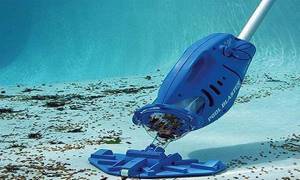
In general, this is not an option, unless you have a pool at your dacha that only holds a cube or two of water, for example, an inflatable pool for children. Then, in principle, the question of cleaning it disappears. But we are talking about medium-sized pools, and therefore we need to look for the right method.
- You can use a distillation pump with filters, but you must understand that it only purifies water. That is, depending on the technology and equipment used, the water will be purified from microscopic impurities and organisms that can create a pathogenic environment;
- You can also use chemicals to clean the pool, which will simply turn the water into a dead state. But again, you will only get rid of bacteria, but not of debris on the surface of the water and plaque on the walls of the pool;
- Using a special net will help collect leaves and pieces of paper from the surface of the water, and a brush with a long handle will help remove some of the plaque from the waterline. But the rest of the dirt will simply settle and remain at the bottom.
As you can see, cleaning a pool that is filled with water is no longer as simple a task as it was previously thought when purchasing a pool. Here it is necessary to use complex methods, one of which will be a vacuum cleaner for the pool.
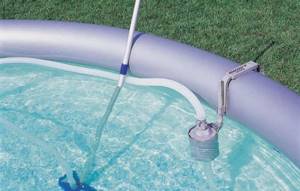
What is a pool vacuum cleaner?
This equipment, without going into too much technical specifications, is a pump for distillation and purification of water with several filters. From the main pump unit there is a long hose with a handle and a brush, through which dirt and plaque are collected. By wiping the bottom and walls of the pool with a brush, bristles or the rubber base of the brush, you remove dirt from the surface, which, along with the water, goes into the hose and reaches the pump, where it is cleaned by passing through a filter or several filters. Depending on the power and general purpose of the pool vacuum cleaner, the filters inside it can even be changed several times during one pool cleaning, it all depends on the severity of the contamination.
A pool vacuum helps with removing sediment as well as buildup that builds up along the waterline.
Most often, these are gray and yellow spots, or even a film that needs to be rubbed well so that it comes away from the walls and the bottom of the pool.
If you work with a pool vacuum cleaner correctly and systematically, it can serve you for quite a long time. In addition, each individual pool cleaning will take much less time.
How is the price of a pool vacuum cleaner determined?
You can buy such equipment without any problems. Today, vacuum cleaners for swimming pools are available from companies offering swimming pools and complete equipment for them, as well as from many wholesalers, online stores, and even in standard retail. But the price tag may vary significantly.
At first glance, you can pay several thousand rubles for a miniature vacuum cleaner, but will it do the job? On the other hand, is it worth purchasing powerful equipment and reproaching yourself for such serious waste for a long time? Probably, it is necessary to determine some alternative method with the help of which it will be possible to find a solution to the issue for minimal money.
If we continue the conversation about the prices of vacuum cleaners for swimming pools, they can reach hundreds of thousands of rubles. For example, robotic vacuum cleaners for swimming pools that independently move along the bottom of the bowl and clean its surface. The same powerful vacuum cleaners from recognized pool manufacturers, recommended, but terribly expensive. Well, and other options, which often cost more than they should.
Therefore, we still recommend reading the next few sections of this material, in which you will find interesting tips.

Types and their features
Most models of vacuum cleaners differ in cost, power, configuration, performance and other characteristics. In addition, today there are 3 basic types of mechanical cleaners: semi-automatic, automatic (robots) and manual.
Automatic devices
The most convenient and effective, but also the most expensive inventions (their price starts from several hundred thousand rubles). Their advantages include: complete immersion of the device under water and completely autonomous performance of work on cleaning the pool; there is no need to connect the robot to the filtration system, as, for example, with manual vacuum cleaners; ability to cope with cleaning even the most severe contaminants; they save energy by performing work at low voltage.
Robot vacuum cleaners have two control methods: programmable and using a remote control. At first, they move along the bottom of the pool, searching for and vacuuming up debris, and then turn off. The second uses the device’s remote control, thanks to which you can remove any contamination from large areas of pools, even those with an elaborate shape.
Important! Underwater robots are great for cleaning huge tanks of liquid of any shape. They cannot be created independently.
Semi-automatic
They operate on hydraulic traction and are able to regulate the flow speed and intensity of water pressure. They are equipped with a drainage pump, a garbage collection bag, and an easy-to-clean cleaning valve (filter). Semi-automatic devices can be connected to a water skimmer (surface water collector). The devices are effective and comfortable for cleaning tanks with a flat bottom without depressions, and are also capable of clearing the bottom of artificial reservoirs from a layer of old silt.
The semi-automatic vacuum cleaner is convenient for cleaning inflatable, stationary and frame pools of medium volumes with different topography and bottom shape. It is very difficult to do it yourself.
Manual
Manual device models are budget (from 3,000 rubles*) and the easiest to use devices. However, they are best used in small pools and artificial reservoirs. Such a vacuum cleaner consists of a brush, a cable for connecting to the electrical network, a metal rod and a corrugated hose, as well as a high-power motor (or pump). As a rule, hand pumps are connected to a skimmer (a device that collects the top layer of water). For ease of operation of the device, the metal rod must be selected according to the depth of the reservoir or pool.
Important! Hand-held vacuum cleaners are convenient for servicing frame and inflatable pools of small sizes. You can make such a vacuum cleaner for a pond yourself.
Alternative cleaning of a small country pool
We decided to continue the theme, starting from small pools for summer cottages. Let it be inflatable or frame pools, because most often these are the ones we have installed. Today we will skip capital and composite pools, since we are absolutely sure that when purchasing a pool for a million or two, no one will bother with a device for cleaning it. The complex system will be purchased on the first day of purchasing the pool.
Let's continue about small plastic plunge pools, inflatable and frame pools. They need to be washed and cleaned, because pool water heated in the sun is an excellent environment for many disease-causing pathogens. Therefore, we get rid of them in several effective ways:
- Every day we cover the pool so that nothing unnecessary gets into it;
- We take procedures only correctly - after a shower, in special swimwear, do not forget to take off your slippers and do not allow animals, even the most beloved ones, into the water;
- We often collect debris from the surface of the water with a net or special plastic buckets;
- We use pool chemicals that will help cope with bacteria, algae and other negatives in the water;
- We change the water in the pool on time;
- And we definitely use cleaning and washing of the dry pool while it is out of water, as well as cleaning and washing with a special vacuum cleaner.
Yes, it will take time, but there is no way around it, especially if you want the procedures to be pleasant and not negatively affect your health.
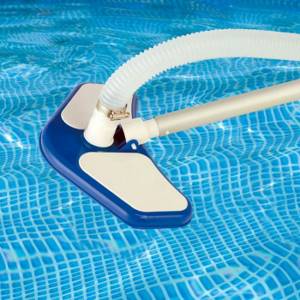
Advantages
Physical cleaning
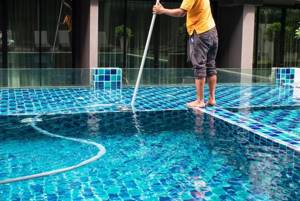
The advantages of vacuum cleaners for cleaning pools are:
- less labor-intensive process of mandatory water purification; ability to cope with any type of pollution;
- reducing the amount of time spent on cleaning and purifying liquids;
- preventing frequent changes of water, and consequently the appearance of ditches and swamps infested with microorganisms;
- simplicity and ease of use.
We invite you to familiarize yourself with the Log house of a bathhouse made of logs with your own hands: construction technology, photos, videos
Today, the use of vacuum cleaners to purify water in swimming pools (regardless of their size and configuration) is considered the most effective way; the management of aquatic entertainment centers put such devices in first place.
DIY pool vacuum cleaner
So that you don’t have to purchase expensive equipment, we will give you advice on how to make it yourself for pennies. You will only need to spend money on high-quality filters for the pump, as well as chemicals for pools.
We decided to bypass several models where the base is created independently. We don't need to think about the design of the pump, because we already have it. But we have thought through the cleaning system to the end.
It's really simple and we'll only need to combine the pump we already have with a few extra parts.
Pool vacuum cleaner brush
The brush is that part of the overall surface cleaning mechanism that will remove plaque from the walls of the pool. It can be used for daily cleaning if necessary, or for tougher dirt if you clean much less frequently.
The brush can be made with your own hands from different materials, or simply purchased at the store. This is far from the most expensive piece of equipment, and therefore everyone can afford the purchase.

If you want to make a brush yourself, there are several options:
- The first is that you simply connect a brush from a home vacuum cleaner to the water intake hose of the pump. Almost every modern household appliance comes with a brush that we don’t use. It has a very narrow slot, flat and small, for cleaning in corners and behind furniture. It can also be used for a swimming pool. But there is one drawback - it is really small, and due to this, cleaning time can seriously increase;
- Brush made of polypropylene pipe. You need to take a pipe, which is used for distributing water in the house, cut off only 20-30 cm from it and make a cut along the pipe only 3-5 mm wide. Next, cut the pipe in half and insert both pieces into a tee, which is also used for wiring in plumbing work. Naturally, you will have to use soldering here. Now, in the third hole of the tee, install another piece of a whole polypropylene pipe, which will become an adapter between our brush and the hose leading to the pump. And the first two pieces of pipe, which have a slot, need to be plugged at the edges; there are also special plugs for this. The brush is ready!
- The third type of homemade brush for a water vacuum cleaner is a modernized brush made from a plastic pipe. That is, we take a ready-made brush that we just created and add several auxiliary parts to it. This can be a rubber band from a regular car windshield wiper that is glued to a pipe with a slot. The rubber band will help remove dirt from the surface. Also, it can be a thin strip with bristles. Any addition can be glued or screwed to the pipe with small screws!
When creating a brush, you need to make all edges without sharp corners so as not to scratch or tear the surface of the pool. You also need to work only with high-quality glue and soldering for polypropylene pipes, so that with minimal force under water the brush does not fall apart. Please also note that the slot in the water intake pipe is offset, depending on the angle of the brush to the walls or bottom of the pool, and the rubber band or bristles that we installed on the brush for scraping off dirt should not get into the slot and interfere suck up dirt.
Connecting a pool vacuum cleaner
Now we need the homemade water vacuum cleaner to work. To do this, it must be airtight, first of all.
We take a simple transparent corrugated hose, which in plumbing work is installed on siphons under sinks, and fix it to the place where water is taken from the pool. Usually it is already there, since through it the pump draws water from the distillation bowl.
Our hose can be connected quite simply, and there are several ways to do this. The first is to use a sewer adapter, choosing it exactly in size so that the elastic fits tightly to the water intake and also tightly grips the hose. And, secondly, use an ordinary plunger, in which you need to make a hole exactly in the middle, where you can install another piece of plastic pipe. Next, the plunger can be put on the water intake, and the vacuum cleaner will be ready to go!
Please note that it is much more convenient to work with rubber sewer adapters or other plumbing parts, since due to the large assortment it will be much easier for you to make the right choice in size.
Another essential part is the handle for the vacuum cleaner. This could again be the same polypropylene pipe 1.5-2 meters long, which will be installed on the brush. With its help, you can set the entire cleaning mechanism in motion.
SUBSCRIBE to OUR YouTube channel Ekonet.ru, which allows you to watch online, download free videos from YouTube about human health and rejuvenation. Love for others and for yourself, as a feeling of high vibrations, is an important factor in healing - econet.ru.
Brief overview of popular brands
Option #1 – Mountfield
The Czech company Mountfield specializes in manual models. Kits for connecting to the skimmer are sold in disassembled form and include at least a telescopic tube-holder (2.5-4.8 m), a corrugated hose of various lengths and a brush attachment. The length of the hose may vary, but on average it is 9 m or 12 m. The cost of the kit is 3,500 rubles.

Mountfield kit parts are sold separately, so if a telescopic rod, hose or attachment fails, they can be easily replaced with similar ones
Option #2 – Pondovac Classic
Owners of picturesque ponds are probably familiar with German pond cleaning devices from Oase. For the most part, these are universal machines used for cleaning both ponds and premises.
The 1400 W Classic model has a large 27 liter debris tank and a large set of attachments, including handy tools specifically for cleaning depressions and crevices or removing string algae. The device is equipped with two hoses: for water suction (4 m) and for draining (2 m). The vacuum cleaner has proven itself to be excellent when working at a depth of up to 2 m. The cost of the device is 11,600 rubles.
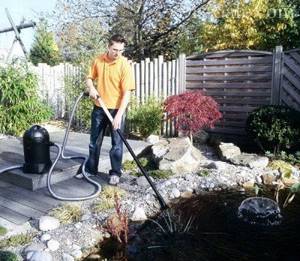
Pondovac Classic is a favorite of practical Germans. In summer it is an excellent helper when cleaning a pond, in winter it is an excellent washing vacuum cleaner for the home, powerful and comfortable to use.
